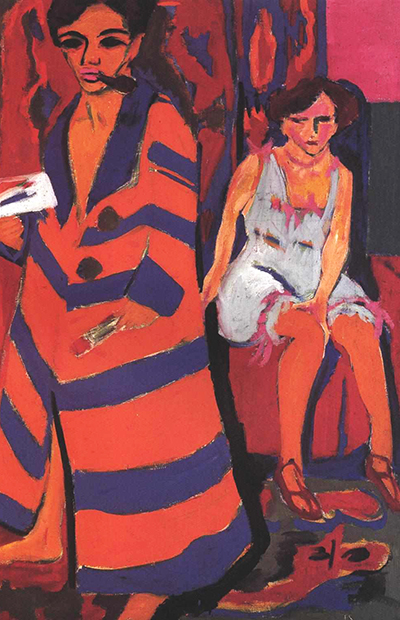Self Portrait with a Model dates from 1910 and is instantly recognisable as being from the hand of German Expressionist, Ernst Ludwig Kirchner.
The artist's coat first captures your attention, with the clashing colours which speak to us from the depths of the artist's soul. Besides the stripes, there is relatively little detail, with just some buttons and a pocket. The artist poses with a dark pipe and stares directly at the viewer. He appears to be naked or in underwear below his coat, suggesting that this is a particularly casual and relaxed environment in which he is working. A model is perched on a small tool in the background, adding interest but without stealing the artist's thunder. She is dressed modestly, with a simple light blue dress or under garment and brown strapped shoes. Could they have been in a relationship at the time, or was this just the artist's casual working process?
The interior of this room is bright but also makes use of the same colour schemes as Kirchner's coat. There again is relatively little detail, just enough to suggest at items in the scene and also to compose the overall structure of the room to provide the most minimal angles of perspective. The artist looks particularly cool, whilst the model appears to look at him longingly. He holds something in his right hand, perhaps an easel as he himself puts a painting together. He appears to be bare footed and there is some detail on the floor, though it is hard to distinguish. Kirchner cleverly crops the piece, meaning neither the tip of his head or his toes is quite 'in shot'. This technique would not have been seen in earlier art movements.
The Die Brück movement, of which this artist was a major figurehead, was classified by some of the aspects that you find in this painting. The bright colours against dark lines to create forms plus the jagged edges and reduced detail was very much in tune with the overall direction of the Expressionists and would greatily influence many artists that followed on afterwards, not just those in Germany. The cropping technique was inspired by the Japanese artists of previous centuries whilst the colours remind us of the Post-Impressionists and also the Fauvists, who both held similar beliefs in allowing the true expression of the creative mind.




